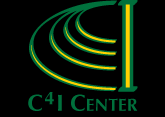
Symposium 2012 Home
Registration
2012 Agenda
Venue & Local Info
C4I
Home
GMU C4I Center-AFCEA Symposium
May 22-23, 2012
SESSION 2: Cutting Edge Research at GMU
_____________________
Crowdsourcing for Intelligence Forecasting
Dr. Charles Twardy
George Mason University
May 22, 2012 at 13:00
ABSTRACT
The DAGGRE project at George Mason University is using a combinatorial prediction market to forecast world events. DAGGRE is one of five forecasting research teams funded by IARPA's ACE program. The goal is substantial improvement in prediction as measured using a time-averaged Brier Score. The baseline prediction is a product of current off-the-shelf crowdsourcing. IARPA plays the neutral arbiter, providing an objective empirical measure of forecast accuracy on dozens of rigorously-vetted questions involving world events. Within the DAGGRE project, participants can use whatever technique they like, and their performance is reflected in their total score and position on the leaderboard, allowing participants and researchers to develop and test various models claiming to improve scores. This presentation describes the Year 1 forecasting results for the DAGGRE project, shares some lessons learned about prediction markets, and makes some recommendations about how combinatorial prediction markets in particular can advance the state of the practice for some types of national security related social science research.
BIO
CHARLES R. TWARDY is a Research Assistant Professor at George Mason University. He received a Dual Ph.D. in History & Philosophy of Science and Cognitive Science, from Indiana University. Dr. Twardy works on evidence and inference from several angles, notably Bayesian network models of reasoning and inference (especially causal inference) and their simpler cousins, argument maps. He leads the Mason DAGGRE team for the IARPA ACE forecasting project, and the SARBayes project for wilderness search & rescue, especially the analysis and prediction of lost person behavior. Previous work involves data analysis and Bayesian modeling for the Counter-IED project, Bayesian credibility models for sensors and human sources, information theoretic sensor selection methods, hierarchical fusion models for image recognition, environmental models, epidemiological models, and game-theoretic Bayesian networks. Recent publications include a 2009 report to the National Research Council on Bayesian methods for Intelligence analysis (particularly IDI's APOLLO project), a 2008 paper on the metaphysics of causal models, a 2006 paper on modeling cardiovascular risk with Bayesian networks, a 2005 article on algorithmic compressibility and inference, and a 2004 article on teaching Argument Mapping.
_____________________
C4I Cloud Computing Security Issues
Dr. Krishna Kant
CSIS
George Mason University
May 22, 2012 at 13:00
ABSTRACT
Cloud computing is emerging as a rapidly growing paradigm for inexpensively and flexibly providing computing infrastructure to clients that may range from individual to users to large enterprises. However, the very advantages of cloud computing bring about a host of new security threats. In particular, the lack of control by a single entity of the entire vertical stack from hardware to services forces the issue of trust between different parties involved. Similarly, the location transparency, flexible sizing, resource sharing between customers, inexpensive availability of computing resources, and the ease of deploying new applications and services all contribute to security risks. In this talk, I will briefly survey these risks, proposed solutions, and the difficulties in providing practical security solutions for the cloud environments. I will also briefly mention our ongoing work in the space of secure collaboration between enterprise clouds.
BIO
KRISHNA KANT is currently a Research Professor at the Center for Secure Information Systems at George Mason University, Fairfax VA. He is also serving as a program director at the National Science Foundation where he runs the Computer Systems Research (CSR) program and is actively involved in driving the foundation wide SEES (Science, Engineering, and Education for Sustainability) program. His current areas of research include robustness in the Internet, cloud computing security, and sustainable computing. He carries 30 years of combined experience in academia, industry, and government. He has published in a wide variety of areas in computer science and has authored a graduate textbook on performance modeling of computer systems. He received his Ph.D. degree in 1981 from University of Texas at Dallas. He has since held positions at Northwestern University, Pennsylvania State University, Bell Labs, Bellcore (Telcordia), Intel, NSF, and GMU.
_____________________
LTC Tom Saltysiak
System Architectures
Laboratory
George Mason University
May 22, 2012 at 13:00
ABSTRACT
Integrating and synchronizing the effects of functional components in military organizations has long been an important principle in all types of military operations. Current approaches to planning integration have largely focused on increasing information and knowledge sharing between parallel planning processes. The proposed approach to integrated planning is focused on common conceptual model creation early in the process. Current planning and operational design activities can be augmented with few coordination activities required to enable common conceptual model agreement. Courses of action developed using a common conceptual model are shown to have a much greater level of integration. The feasibility of this approach is demonstrated through a combination of planning process modeling and course of action performance modeling. The proposed approach provides an viable alternative for consideration in the development of command and control architectures.
BIO
TOM SALTYSIAK is an intelligence and material acquisition officer in the United States Army. He is currently a PhD candidate conducting research at the George Mason University System Architectures Laboratory. He most recently served as Assistant Product Manager for the United States Army Tactical Exploitation of National Capabilities (TENCAP) Program from 2008-2009. In that capacity, he led the Army's portion of the Military Exploitation of Reconnaissance and Intelligence Technology (MERIT) and Imagery Work Station programs. In 2007-2008, he led the Iraq, Kuwait, and Qatar portions of the Distributed Common Ground Station - Army (DCGS-A) intelligence system. He was the assistant United States Army Training and Doctrine Command Systems Manager for Tactical Radios in 2003-2005. He holds a BS in Chemistry from North Georgia College and State University and a MS in Systems Engineering from George Mason University.
_____________________
